Hellish
During the Battle of Britain, fighter pilots were regarded as sky heroes, almost knights of the Round Table, who had the honor of defending the kingdom against the Germanic hordes. At first, they themselves were not fully aware of the brutality of the fight in the air. As one of them put it nicely: this pack of little John Wayne's handed out was only beer, women and spitfires .
Unfortunately, the statistics were inexorable. For many of these boys, the sky adventure ended in a brutal death.
Defenders of the Empire
Many British pilots were 19-20 years old and fresh out of flight school. Twentysomethings could consider themselves old bastards. A rookie coming from a training unit to a fighter squadron, did not have the right to survive the first five combat flights . When he miraculously succeeded in doing so, his chances of survival grew, but fell again after twenty flights.
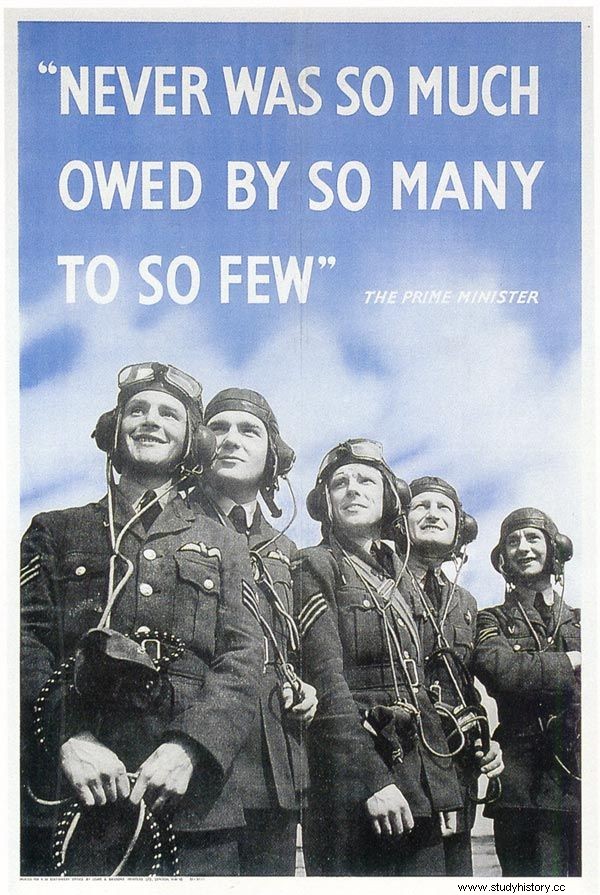
"Never before have so many owed so much to so few" these words of Winston Churchill encouraged young people to join the RAF (source:public domain).
The novice usually got the worst, most often shot and patched plane. In addition, it was operated by the most inept and lazy mechanics in the squadron. In the air, it was usually last in the formation and was particularly vulnerable to attacks by Luftwaffe fighters .
During the heaviest air battles over England, in August and September 1940, service in RAF fighter units was particularly hard. Lieutenant Colonel Peter Matthews, pilot of the 1st Squadron from Northolt recalled:
We went to bed just after dark, tried to take a nap, and then again… The worst part was waiting. We sat with our stomachs tight and played poker . (…) During the day we were picked up three, four or even five times. We were in the air for no more than 30 or 45 minutes. We endured it somehow because we were young.
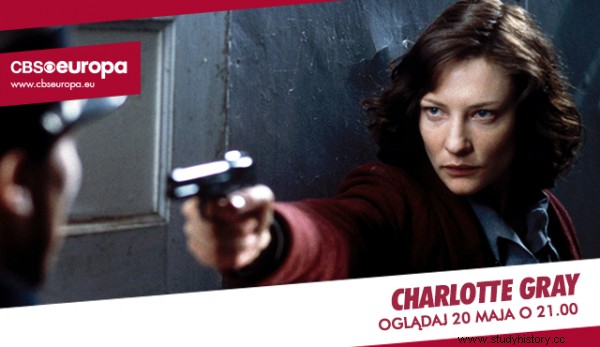
The inspiration for this article was the movie "Charlotte Gray", available to watch today, May 20, at CBS Europe!
In the cockpit
Piloting a fighter in 1940 is an extremely unrewarding job. The cockpit of the "Spitfire" or "Hurricane" was cramped, even claustrophobic. It is difficult to enter, let alone get out of the damaged plane in the air . To do this, the easiest way was to make a semi-barrel, i.e. turn the machine with the chassis upwards, slide the cabin cover aside and let the force of gravity act. One had to be careful not to accidentally hit the tail of the plane.
At higher altitudes, the airmen felt biting cold. At a ceiling of 7.5 thousand meters, the temperature was thirty degrees below zero, and the pilot's cabin was not heated in any way. It was full of exhaust fumes, high-octane aviation gasoline vapors or burnt oil. No one was surprised at the instrument panel, battered with vomit.
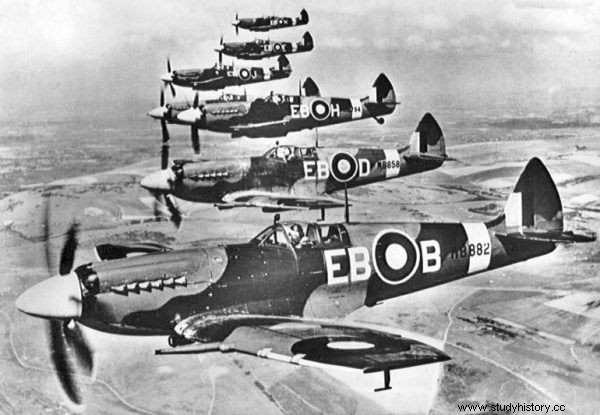
In these planes, British airmen fought not only against the Nazi aggressor, but also against the cold and their own weaknesses (source:public domain).
The maneuvering fight was like a Ferris wheel and was very exhausting physically . The stiff hands had to be jerked sharply with the control stick, and the cold feet were constantly kicked by the rudder pedals. In addition, there was a pain in the neck, as the pilots constantly looked around for the enemy.
The clocks in the cabin swirled to the rhythm of the aircraft's evolution, and the chaos was further intensified by the radio, which alternately crossed the commands and warnings of commanders and cries of victory or despair colleagues shot down. In such conditions, you had to keep an eye on your place in the formation, keep an eye on the wingman, locate the enemy, aim, hit ...
Death in a thousand ways
Fighter planes died not only from enemy aircraft shells. They were equally often killed in disasters caused by unexpected, difficult weather conditions, sometimes in the fire of their own anti-aircraft artillery, after becoming entangled in the ropes of barrier balloons, by misappraising the tactical situation, and finally as a result of mere human negligence. They were also suffering from "gremlins", i.e. inexplicable mechanical failures that occur even after meticulous checks of the machines.

Peter Townsend (left) and C. B Hull - one of the greatest duos in the history of the Royal Air Force (source:public domain).
The flames were most afraid of the airmen. The famous hunter Peter Townsend even stated that war is a morgue in which most of my friends have turned into burned, mutilated corpses . Death in this case seemed to be a salvation from a life marked by pain with parts of the body deformed by fire. Sometimes there were even drastic situations.
Polish pilot Witold Herbst witnessed an emergency landing without an advanced Spitfire undercarriage, piloted by a squadmate, Lieutenant Tadeusz Kołecki. The hapless pilot did not throw away his spare fuel tank, which still contained gasoline, and was trapped in the wreckage . The smashed plane caught fire and the fire truck got stuck somewhere on the edge of the airport.

"Give us the tools and…". This is how British soldiers were motivated to fight. Poster by Frank Newbould (source:public domain).
Apart from Herbst, there was also Second Lieutenant Roman Brygider. Then there were heart-rending scenes:
The pilot - stunned or injured - started screaming in horror. We stood paralyzed. We saw in the flames the silhouette of the pilot trying to open the cockpit. (...) Brygider made the first decision. He drew his pistol aiming at Kolchak. He missed. I reached for my gun. Box. The scream in the pilot's cabin turned into an inhuman howl. (…) I threw myself to the ground and, using the bicycle frame as a base, I shot again. The howling stopped. Kolchak was dead.
This article has more than one page. Please select another one below to continue reading.Attention! You are not on the first page of the article. If you want to read from the beginning click here.
A good joke worth a pound
The fighter pilots liked to joke around, and every opportunity seemed to be good for them. A certain incident is characteristic here, the protagonist of which was a Polish aviator, unknown by name and surname. He participated in a course organized by the British for our pilots. One of the instructors had some rather unusual training methods.
Each time during the last flight summarizing the training of a given student, sitting in the rear cabin Tiger Motha, nudged him and showed the removed control stick . This was to make the young aviation adept realize that from that moment on, he was doomed only to his own strength.

The inspiration for this article was the movie "Charlotte Gray", available to watch today, May 20, at CBS Europe!
The Pole found out about it and informed his colleagues to watch his flight closely. Tiger Moth took to the air. After some time, the observers below saw the machine suddenly collapsing downwards and a man on a parachute jumped out of it! After a while the plane straightened out, made a lot of beautiful evolutions and landed calmly.
What did the Pole do? When the Briton customarily tapped his shoulder and showed what he was holding in his hand, the Brit turned and ... threw away his own control stick! The poor instructor did not know only that it was a spare stick previously prepared by a Polish joker. The terrified Englishman, convinced that he was saving his own life, immediately lowered in his opinion the machine that dipped to the ground.
Love twists
Tired of combat flights, stressed, and not knowing their day or time, fighter pilots often threw themselves into the whirlwind of loud, heavily alcohol-drenched parties. Everyone was tempted especially by the charms of London with its nightclubs where on the dance floor, in the company of young women, you could have fun to the rhythm of the hits of the time and forget about the reality of war for a moment. It was during one such party that the title character of the movie "Charlotte Gray" met her beloved, RAF lieutenant Peter Gregory.
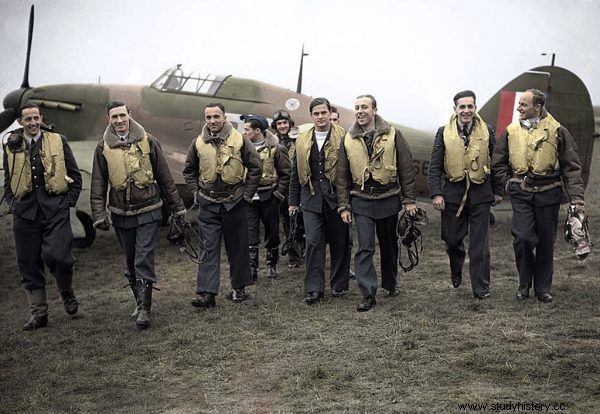
Dywizjonu 303. The best pilots and biggest female heartbreakers in Great Britain (source:public domain).
Puffs of cigarette smoke rose to the ceiling, the atmosphere was thick with sex, and traditional morality was going into a corner - this quote probably best describes the mood that prevailed there.
Among the "podrywacze", of course, Poles were in the lead . Gallant, kissing the hand of the fair sex, they quickly became the object of admiration and often envy of their British colleagues. Polish pilots have spread out at our airport and requisition everything that is nice and modest The British sometimes complained bitterly. The more enterprising of them would get "Poland" patches on their uniforms and in this way "caught" their countrymen.
Bed battles
British - as our hunting ace Jan Zumbach wrote - they were (...) nice, accessible and friendly . Zumbach himself had a funny love adventure, when he was lured to the apartment of a certain Ann. There, while waiting for intimate games, he accidentally discovered the diary of the said Englishwoman.
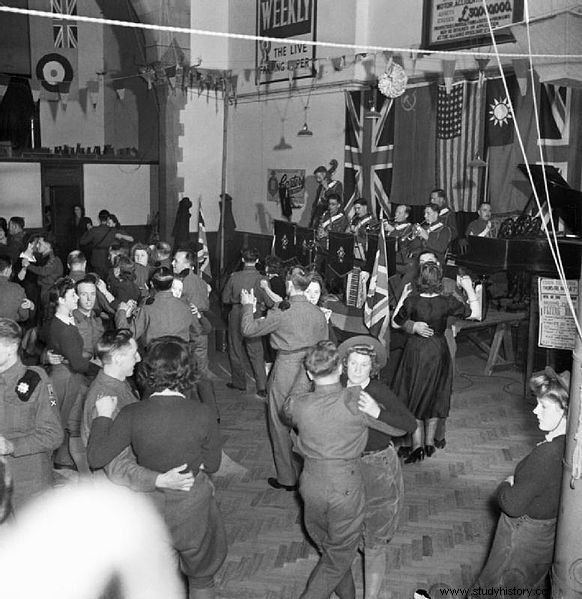
Despite the hostilities, there was always time to play. Photo taken in Suffolk (Source:Public Domain).
If I hadn't been in bed anymore, I would have probably collapsed. (...) If only because on the pages of my diary I found the names of many of my colleagues from the squadron. Ann rated all of them very good, while she was rather critical of her compatriots in love.
Polish fighters are also remembered by a group of young, unassuming English women who are extremely skilled in "escorting" them from the dance hall to their beds. The girls, due to their many qualities, were called by our pilots "messerschmitts".
***
1942. Young Scottish girl Charlotte Gray travels to London to serve her homeland. In the capital, Charlotte works in a hospital. One day at a party she meets RAF Lieutenant Peter Gregory. A feeling is born between Charlotte and the man. Soon Peter is sent to France, where his plane is shot down by the Germans. Desperate Charlotte takes a job for British intelligence.
The 2001 film "Charlotte Gray" was based on the novel by Sebastian Faulks. Cate Blanchett played the main role, creating a distinctive character that evolves under the influence of dramatic experiences. An outstanding performance was created by the great British actor Sir Michael Gambon. Charlotte Gray is available today, May 20, on CBS Europa!

